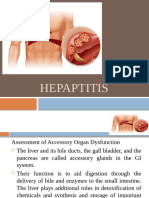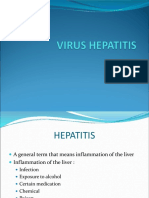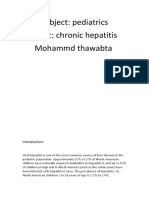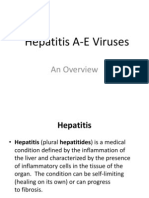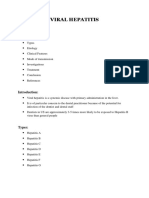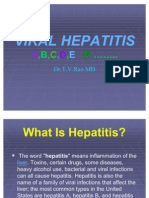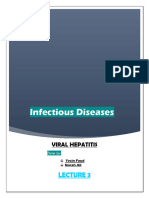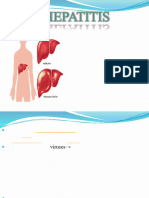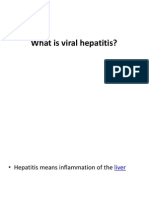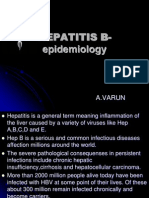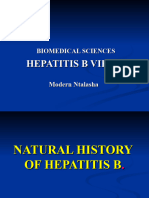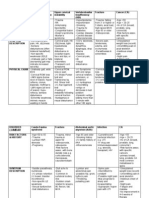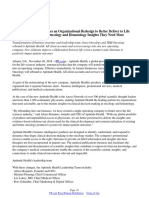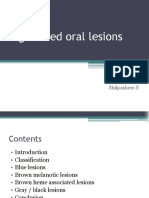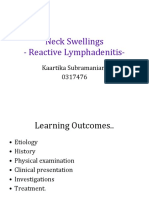0 ratings0% found this document useful (0 votes)
57 viewsHepatitis B (Serum Hepatitis)
Hepatitis B (Serum Hepatitis)
Uploaded by
Lauraruth Pelino FinezHepatitis B is a viral infection that causes inflammation of the liver. It can lead to both acute and chronic liver disease. The virus is transmitted through bodily fluids and is highly infectious. While a safe and effective vaccine exists, hepatitis B remains a global health problem as approximately 350 million people have chronic infections and 600,000 die each year from its consequences including liver cancer.
Copyright:
© All Rights Reserved
Available Formats
Download as DOCX, PDF, TXT or read online from Scribd
Hepatitis B (Serum Hepatitis)
Hepatitis B (Serum Hepatitis)
Uploaded by
Lauraruth Pelino Finez0 ratings0% found this document useful (0 votes)
57 views8 pagesHepatitis B is a viral infection that causes inflammation of the liver. It can lead to both acute and chronic liver disease. The virus is transmitted through bodily fluids and is highly infectious. While a safe and effective vaccine exists, hepatitis B remains a global health problem as approximately 350 million people have chronic infections and 600,000 die each year from its consequences including liver cancer.
Original Title
Hepatitis B
Copyright
© © All Rights Reserved
Available Formats
DOCX, PDF, TXT or read online from Scribd
Share this document
Did you find this document useful?
Is this content inappropriate?
Hepatitis B is a viral infection that causes inflammation of the liver. It can lead to both acute and chronic liver disease. The virus is transmitted through bodily fluids and is highly infectious. While a safe and effective vaccine exists, hepatitis B remains a global health problem as approximately 350 million people have chronic infections and 600,000 die each year from its consequences including liver cancer.
Copyright:
© All Rights Reserved
Available Formats
Download as DOCX, PDF, TXT or read online from Scribd
Download as docx, pdf, or txt
0 ratings0% found this document useful (0 votes)
57 views8 pagesHepatitis B (Serum Hepatitis)
Hepatitis B (Serum Hepatitis)
Uploaded by
Lauraruth Pelino FinezHepatitis B is a viral infection that causes inflammation of the liver. It can lead to both acute and chronic liver disease. The virus is transmitted through bodily fluids and is highly infectious. While a safe and effective vaccine exists, hepatitis B remains a global health problem as approximately 350 million people have chronic infections and 600,000 die each year from its consequences including liver cancer.
Copyright:
© All Rights Reserved
Available Formats
Download as DOCX, PDF, TXT or read online from Scribd
Download as docx, pdf, or txt
You are on page 1of 8
Hepatitis B (Serum Hepatitis)
Hepatitis B is the inflammation of the liver caused by hepatitis B virus.
This is considered to be more serious than hepatitis A due to the possibility of
severe complications such as massive damage and hepatocarcinoma of the
liver.
Hepatitis B is a viral infection that attacks the liver and can cause both acute
and chronic disease.About 2 billion people worldwide have been infected with
the virus and about 350 million live with chronic infection.
An estimated 600 000 persons die each year due to the acute or chronic
consequences of hepatitis B.
About 25% of adults who become chronically infected during childhood later
die from liver cancer or cirrhosis (scarring of the liver) caused by the chronic
infection.
The hepatitis B virus is 50 to 100 times more infectious than HIV.
Hepatitis B virus is an important occupational hazard for health workers.
Hepatitis B is preventable with a safe and effective vaccine.
Etiologic Agent:
The disease is caused by Hepatitis B virus
1. This virus has very limited tissue tropism
2. HBV infects the liver and possibly the pancreas.
3. HbsAg appears in the blood 30 to 60 days after exposure and
persists for variable periods of time.
Incubation Period:
The incubation period is 50 to 189 days or two to five months with a mean
equal to 90 days.
Period of Communicability:
The patient is capable of transmitting the virus during the latter part of the
incubation period and during the acute phase. The virus may persist in the
blood for many years.
Mode of Transmission:
1. Hepatitis B can be directly transmitted by person to person contact via
infected body fluids.
2. It can be transmitted though contaminated needles and syringes.
3. Transmission can occur through infected blood or body fluids introduced at
birth.
4. It can also be transmitted through sexual contact.
HBV transmission does not occur.
1. by fecal-oral route
2. by food-borne or water-borne transmission
3. by arthropod (mosquito) transmission.
Pathogenesis:
1. HBV can cause acute or chronic hepatitis.
2. Production of virus and high level of HbsAg is continuous and the particles are
found in the blood until the infections is resolved.
3. The virus must be delivered into the liver to establish infection.
4. The virus replicates and large amount of HbsAg is released into the blood.
5. Initiation of virus replication may be as short as three days from acquisition,
but symptoms may not be observed for 45 days or much longer.
6. Replication of the virus is not cytopathic and proceeds to relatively long
periods without causing liver damage.
7. During the acute phase of infection, the liver parenchyma shows degenerative
changes consisting of cellular swelling and necrosis, especially in hepatocytes.
Clinical Manifestations:
1. Prodormal period
Fever, malaise, and anorexia.
Nausea, vomiting, abdominal discomfort, fever and chills.
Jaundice, dark urine, and pale stools.
Recovery is indicated by a decline of fever and improved appetite.
2. Fulminant hepatitis may be fatal and manifested by severe symptoms like
ascitis and bleeding.
Diagnostics Procedures:
1. Compliment fixation test
2. Radio-immunoassay-hemaglutinin test
3. Liver function test
4. Bile examination in blood and urine
5. Blood count
6. Serum transaminase SGOT, SGPT, ALT
7. HbsAg
Prevention:
1. Blood donors must be screened to exclude
carriers.
2. Caution must be observed in giving care to
patients with known HBV.
3. Hands and other skin areas must be washed
immediately and thoroughly after contact
with body fluids.
4. Avoid injury with sharp objects or instruments.
5. Use disposable needles and syringes only once and discard properly.
6. Avoid sharing of toothbrush, razor, and other instruments that may be
contaminated with blood.
7. Observe safe sex.
8. Have adequate rest, sleep, and exercise and eat nutritious food.
9. Hepatitis B vaccine is recommended for pre-exposure.
10. Hepatitis Immune Globulin (HBIg) should be administered within 72 hours to
those exposed directly to hepatitis B virus either by ingestion, by prick or by
inoculation.
Viral Hepatitis
Is a viral infectionof the liver associated with a broad spectrum of clinical
manifestations from asymptomatic infection through icteric hepatitis to hepatic
necrosis.
Five forms of viral hepatits:
Type A Hepatitis (HAV)
Is caused by an RNA virus of the enterovirus family.
It spreads primarily by fecal-oral route, usually through the ingestion of
infected food or liquids.
It may also spread from person-to-person contact and, rarely, by blood
transfusion.
Type A hepatitis occurs worldwide, especially in areas with overcrowding and
poor sanitation.
Type B Hepatitis (HBW)
Is caused by a double-shelled virus containing DNA.
It spreads primarily through blood (percutaneous and permucosal route).
It can also spread by way of saliva, breast feeding, or sexual activity (blood,
semen, saliva, or vaginal secretions.
Male homosexuals are at high risk for infection.
After acute infection, 10% of patients progress on to carrier status or develop
chronic hepatitis.
HBV is the main cause of cirrhosis and hepatocellular carcinoma.
Type C Hepatitis (HCV)
Formerly called non-A, non-B hepatitis, usually spreads through blood or
blood product transfusion, usually from asymptomatic blood donors.
It may also be transmitted through unsterile piercing or tattooing tools or dyes.
It commonly affects I.V. drug users and renal dialysis patients and personnel.
HCV is the most common form of postransfusion hepatitis.
Type D Hepatitis (HDV)
Also known as Delta hepatitis.
Is caused by a defective RNA virus that requires the presence of hepatitis B-
specifically, hepatitis B surface antigen (HBsAg) to replicate.
HDV occurs along with HBV or may superinfect a chronic HBV carrier, and
cannot outlast a hepatitis B infection.
It occurs primarily in I.V. drug abusers or those who have had multiple blood
transfusions, but the highest incidence is in the Mediterranean, Middle East,
and South America.
Type E Hepatitis (HEV)
Is caused by a nonenveloped, single-strand RNA virus.
It transmitted by the fecal-oral route but is hard to detect because it is
inconsistently shed in the feces.
Its occurence is primarily in India, Africa, Asia, or Central America.
Fulminant Hepatitis
Is a rare but severe complication of hepatitis, which may require liver
transplantation.
Assessment:
Type A hepatitis
Incubation period, 3 to 5 weeks.
Prodromal symptoms: fatigue, anorexia, malaise, headache, low-grade fever,
nausea, vomiting. Highly contagious at this time, usually 2 weeks before onset
of jaundice.
Icteric phase: jaundice, tea-colored urine, clay0colored stools, right upper
quadrant pain and tenderness.
Symptoms often milder in children.
Type B hepatitis
Incubation period, 2 to 3 months.
Prodronal symptoms (insidious onset): fatigue, anorexia, transient fever,
abdominal discomfort, nausea, vomiting, headache.
May also have myalgias, photophobia, arthritis, angioedema, urticaria,
maculopapular rash, vasculitis.
Icteric phase occurs 1 week to 2 months after onset of symptoms.
Type C hepatitis
Incubation period, 6 weeks to several months.
Similar to HBV but less severe.
Type D hepatitis
Unclear incubation period.
Similar to HBV but more severe.
Applicable to all type:
Obtain a patient history. Ask about I.V. drug use, blood transfusions, contact
with infected persons (including sexual activity), travel to endemic areas, and
ingestion of possible contaminated food or water to help determine cause of
hepatitis.
Diagnostic Evaluation:
1. All forms of hepatitis; elevated serum transferase levels (aspartate
aminotransferase, lanine aminotransferase); may have abnormal clotting tests.
2. HAV: radioimmunoassay detects immunoglobulin M (IgM) antibodies to
hepatitis A virus in the acute phase.
3. HBV: radioimmunoassays detect hepatitis B surface antigen (HBsAg),
antibody to hepatitis B core antigen (anti-HBc), anti-HBsAg in various stages
of hepatitis B infection.
4. HCV: hepatitis C antibody may not be detected for 3 to 6 months after onset of
illness (used for screening); polymerase chain reactiontesting evaluates viral
activity.
5. HDV: anti-delta antibodies in the presence of HBsAg, or detection of IgM in
acute disease and IgG in chronic disease.
6. Hepatitis E antigen (with HCV ruled out).
7. If indicated, prepare the patient for liver biopsy to detect chronic active
disease, track progression, and evaluate response to therapy.
Pharmacologic Interventions:
1. Vitamin K injected subcutaneously (S.C.) if prothrombin time is prolonged.
2. I.V. fluid and electrolyte replacements as indicated.
3. Antiemetic for nausea.
4. Long-term interferon therapy in combination with oral ribavirin may produce
remission inHCV patients. Peginterferon alfa-2b is a long-acting preparation
given S.C., once per week, and ribavirin is taken twice daily.
5. Antiviral treatment is being investigated for HBV.
Nursing Interventions:
1. Monitor hydration through intake and output.
2. Monitor prothrombin time and for signs of bleeding.
3. Encourage the patient to eat meals in a sitting position to reduce pressure on
the liver.
4. Encourage pleasing meals in an environment with minimal noxious stimuli
(odors, noise, and interruptions).
5. Teach self-administration of antiemetics as prescribed.
6. Encourage rest during symptomatic phase, according to level of fatigue.
7. Encourage diversional activities when recovery and convalescence are
prolonged.
8. Encourage gradual resumption of activities and mild exercise during
convalescent period.
9. Stress importance of proper public and home sanitation and proper preparation
and dispensation of foods.
10. Encourage specific protection for close contacts.
11. Explain precautions about transmission and prevention of transmission to
others to the patient and family.
12. Warn the patient to avoid trauma that may cause bruising.
13. Stress the need to follow precautions with blood and secretions until the
patient is deemed free of HBsAg.
14. Emphasize that most hepatitis is self-limiting, but follow up is needed for liver
function tests.
You might also like
- Cardiology EssentialsDocument396 pagesCardiology Essentialsanna100% (18)
- MRCS NotesDocument672 pagesMRCS Notessuggaplum100% (8)
- FC Sem 1 Substance Abuse - Impact On Youth and Challenges For The Future PDFDocument17 pagesFC Sem 1 Substance Abuse - Impact On Youth and Challenges For The Future PDFIrfan Khan100% (1)
- Acr Practice Parameter For Breast UltrasoundDocument7 pagesAcr Practice Parameter For Breast UltrasoundBereanNo ratings yet
- Hepatic DisordersDocument15 pagesHepatic DisordersKenneth OpinaNo ratings yet
- Viral Hepatitis Nursing Care Plan and Management: DescriptionDocument128 pagesViral Hepatitis Nursing Care Plan and Management: DescriptionnatalieshirleyNo ratings yet
- HepatitisDocument40 pagesHepatitisVISHAL DUBEYNo ratings yet
- HepatitisDocument33 pagesHepatitis012211009No ratings yet
- Hepatitis A, B, C, D, E.group1Document34 pagesHepatitis A, B, C, D, E.group1R الالمعيNo ratings yet
- Hepatitis A, B, C: Clarissa Isidra D.Guiang BSNDocument33 pagesHepatitis A, B, C: Clarissa Isidra D.Guiang BSNPatricia EngalladoNo ratings yet
- Hepatits: Nitha K 2nd Year MSC NursingDocument88 pagesHepatits: Nitha K 2nd Year MSC NursingNITHA KNo ratings yet
- Hepatitis ADocument15 pagesHepatitis Azakariah kamal0% (1)
- Hepatitis Doc LectureDocument12 pagesHepatitis Doc LectureDr. Muhammad RazzaqNo ratings yet
- Viral Hepatitis: Prepared By: Dr. Laila T. Sabei 2015-2016Document12 pagesViral Hepatitis: Prepared By: Dr. Laila T. Sabei 2015-2016Hannan AliNo ratings yet
- Viral HepatitisDocument12 pagesViral HepatitisHeart Of Ayurveda Beatrice DNo ratings yet
- 5 - Alaa VIRAL HEPATITISDocument28 pages5 - Alaa VIRAL HEPATITISAli SafaaNo ratings yet
- HEPATITISDocument4 pagesHEPATITISAMOS MELINo ratings yet
- Virus Hepatitis 1 PDFDocument92 pagesVirus Hepatitis 1 PDFmuhammad dimasNo ratings yet
- Subject: Pediatrics Topic: Chronic Hepatitis Mohammd ThawabtaDocument18 pagesSubject: Pediatrics Topic: Chronic Hepatitis Mohammd ThawabtaAnonymous OQLf4WNo ratings yet
- وبائياتDocument60 pagesوبائياتwalidmaruod3No ratings yet
- Hepatitis ADocument21 pagesHepatitis Avanessa100% (6)
- HEPATITIS BDocument5 pagesHEPATITIS Blawrence agbortabiNo ratings yet
- Hepatitis (1)Document38 pagesHepatitis (1)abramazme09No ratings yet
- HEPATITISDocument6 pagesHEPATITISSimon LexsNo ratings yet
- Hepatitis ADocument8 pagesHepatitis ABetty Aulia DoloksaribuNo ratings yet
- Viral HEPATITIS PPT by ApplemberDocument45 pagesViral HEPATITIS PPT by ApplemberEmpress ApplemberNo ratings yet
- Heptitis Meninigitis For DentalDocument47 pagesHeptitis Meninigitis For Dentalمنير الجبريNo ratings yet
- Hepatitis A-E Viruses: An OverviewDocument49 pagesHepatitis A-E Viruses: An OverviewDeepak VermaNo ratings yet
- Viral Hepatitis: by Shalini Hazael, Group 40aDocument24 pagesViral Hepatitis: by Shalini Hazael, Group 40aAiman TymerNo ratings yet
- Hepatitis VirusesDocument23 pagesHepatitis Viruses4jzbxz64kqNo ratings yet
- Hepatitis ADocument58 pagesHepatitis AClaireGrandeNo ratings yet
- HepatitisDocument18 pagesHepatitisakkusingh439No ratings yet
- HepatitisDocument95 pagesHepatitisabdishakour mohamedNo ratings yet
- HepatitisDocument42 pagesHepatitisQusaiBadrNo ratings yet
- Hepatitis A BDocument5 pagesHepatitis A BLouise OpinaNo ratings yet
- Acute HepatitisDocument34 pagesAcute HepatitisThoma KumaraNo ratings yet
- Hepatitis A & B Power PointDocument15 pagesHepatitis A & B Power PointHerlina Marshal100% (1)
- Name: Ma Rupina B. Ponce Course: Bachelor of Science Major in Nursing Section: C Hepatitis DefinitionDocument13 pagesName: Ma Rupina B. Ponce Course: Bachelor of Science Major in Nursing Section: C Hepatitis DefinitionMaria Pina Barbado PonceNo ratings yet
- Hepatitis D VirusDocument14 pagesHepatitis D Virusikechidiebere766No ratings yet
- Viral-Hepatitis RCPTANDocument43 pagesViral-Hepatitis RCPTANAlthea AlbaniaNo ratings yet
- Viral HepatitisDocument8 pagesViral HepatitisPoka DineshNo ratings yet
- Dr.T.V.Rao MD Dr.T.V.Rao MDDocument108 pagesDr.T.V.Rao MD Dr.T.V.Rao MDprithviraj_tarafdarNo ratings yet
- Infecious Disease L-3Document6 pagesInfecious Disease L-3v2vxxb452pNo ratings yet
- Hepatitis PCM 332.2 Pathology 2Document35 pagesHepatitis PCM 332.2 Pathology 2Olusegun Raphael DipeoluNo ratings yet
- HepatitisDocument29 pagesHepatitishussain AltaherNo ratings yet
- Hepatology - GSH (Kapita Selekta)Document50 pagesHepatology - GSH (Kapita Selekta)Dwi WulandariNo ratings yet
- HepatitisDocument40 pagesHepatitispournimakhairnar890No ratings yet
- Hepatitis C Virus: Section: 3Document43 pagesHepatitis C Virus: Section: 3Aymen OmerNo ratings yet
- HepatitisDocument17 pagesHepatitismuhammadyawarsaeed4No ratings yet
- Infections of The Gastrointestinal TractDocument32 pagesInfections of The Gastrointestinal Tract180045No ratings yet
- Hepatitis A-E VirusDocument4 pagesHepatitis A-E VirusPorcha PacsayNo ratings yet
- Hepatitis A /BDocument79 pagesHepatitis A /BnasibdinNo ratings yet
- Hepatitisaandb Infections: Jennifer ThuenerDocument9 pagesHepatitisaandb Infections: Jennifer ThuenerWilliam David Ramos AnayaNo ratings yet
- GIT Viral Hepatitis in Children - PPT 93Document22 pagesGIT Viral Hepatitis in Children - PPT 93Dr.P.NatarajanNo ratings yet
- HEPATITIS B EpidemiologyDocument14 pagesHEPATITIS B Epidemiologytarun_apr25No ratings yet
- Hepatitis B InfectionDocument18 pagesHepatitis B InfectionmcpaulfreemanNo ratings yet
- 8-Hepatitis CDocument78 pages8-Hepatitis CWara RizkyNo ratings yet
- Clinical Conditions of Hepatitis BDocument2 pagesClinical Conditions of Hepatitis BnurseNo ratings yet
- Overview of HepatopathologyDocument158 pagesOverview of Hepatopathologyamy100% (1)
- Hepatitis B (HepB Vaccine)Document6 pagesHepatitis B (HepB Vaccine)Desiree EscobidoNo ratings yet
- Hepatitis A, BDocument26 pagesHepatitis A, BSreelakshmi MNo ratings yet
- Viral Hepatitis: References: Harrisons Infectious Disease 2 Ed., Oxford Handbook of Microbiology and IdDocument58 pagesViral Hepatitis: References: Harrisons Infectious Disease 2 Ed., Oxford Handbook of Microbiology and IdMohammad Emad Al MadadhaNo ratings yet
- Lec 7Document31 pagesLec 7kale.rebwar2004No ratings yet
- Fractures and HomeopathyDocument3 pagesFractures and HomeopathyAnonymous dpxYTE100% (1)
- Fertilisation Implantation NotesDocument4 pagesFertilisation Implantation NotesShaun JinNo ratings yet
- Red Flags in Orthopedic Physcial TherapyDocument4 pagesRed Flags in Orthopedic Physcial Therapyadamandersen100% (2)
- Concept Map Complex Care 2017Document7 pagesConcept Map Complex Care 2017api-401537905No ratings yet
- Ber IliumDocument76 pagesBer IliumMulki RachmawatiNo ratings yet
- Therapy Langévin Alfred Loomis William FryDocument2 pagesTherapy Langévin Alfred Loomis William Fryapi-353664189No ratings yet
- Full Download Vegetarian and Plant-Based Diets in Health and Disease Prevention Mariotti PDF DOCXDocument41 pagesFull Download Vegetarian and Plant-Based Diets in Health and Disease Prevention Mariotti PDF DOCXpremokracl1y100% (5)
- Adherence To Refills and Medications Scale ArmsDocument1 pageAdherence To Refills and Medications Scale ArmsMoch AzrilNo ratings yet
- Radiation Retinopathy Detection and Management StrategiesDocument14 pagesRadiation Retinopathy Detection and Management StrategiesayminayilikNo ratings yet
- Catharina Hunter Call With KSAT 12 Producer On June 3Document4 pagesCatharina Hunter Call With KSAT 12 Producer On June 3Dillon CollierNo ratings yet
- Risk Assessment For Metalworking Fluids and Cancer OutcomesDocument6 pagesRisk Assessment For Metalworking Fluids and Cancer OutcomeshemakumarsNo ratings yet
- Nursing Care PlanDocument2 pagesNursing Care PlanMa Rafaela Rosales PalomponNo ratings yet
- Aptitude Health Announces An Organizational Redesign To Better Deliver To Life Sciences Companies The Oncology and Hematology Insights They Need MostDocument3 pagesAptitude Health Announces An Organizational Redesign To Better Deliver To Life Sciences Companies The Oncology and Hematology Insights They Need MostPR.comNo ratings yet
- Resume 6-18-18Document2 pagesResume 6-18-18api-401933086No ratings yet
- Pigmented Oral LesionDocument133 pagesPigmented Oral LesionArnela UniqueNo ratings yet
- Cryptogenic StrokeDocument52 pagesCryptogenic Strokemrabhilekh100% (1)
- Domperidone-Oral: Generic Name: Domperidone - Oral (Dom-Pair-Eh-Doan)Document7 pagesDomperidone-Oral: Generic Name: Domperidone - Oral (Dom-Pair-Eh-Doan)Pusparasmi Mas Ayu SuprabhaNo ratings yet
- PDD, MSDS, Battery, Leoch, 2015-01, Lead Acid Battery - Huse2015 - Aaen - Msds Battery - LeochDocument7 pagesPDD, MSDS, Battery, Leoch, 2015-01, Lead Acid Battery - Huse2015 - Aaen - Msds Battery - LeochMarco Antonio Valdez RojasNo ratings yet
- Efficacy of Dexamethasone Versus Fluticasone Nasal Sprays in Postoperative Patients With Chronic Rhinosinusitis With Nasal PolypsDocument5 pagesEfficacy of Dexamethasone Versus Fluticasone Nasal Sprays in Postoperative Patients With Chronic Rhinosinusitis With Nasal PolypsandiniNo ratings yet
- V. AlcoholDocument17 pagesV. AlcoholGeorge TsangNo ratings yet
- Pathology Interview Book SampleDocument22 pagesPathology Interview Book SampledeeptiatitsbestNo ratings yet
- Psychosomatic DisordersDocument79 pagesPsychosomatic DisordersMONIKA100% (1)
- Proiectarea Tehnologica A Unei Instalatii de Hidrofinare A Unui Amestec de Benzine de DA Si CCDocument31 pagesProiectarea Tehnologica A Unei Instalatii de Hidrofinare A Unui Amestec de Benzine de DA Si CCIlieRobertNo ratings yet
- Neck Swellings - Reactive LymphadenitisDocument17 pagesNeck Swellings - Reactive LymphadenitisK'rtika SubramaniamNo ratings yet
- Environics Paper On Geopathic StresDocument5 pagesEnvironics Paper On Geopathic StresramachariNo ratings yet
- Manual Planejamento Familiar PDFDocument388 pagesManual Planejamento Familiar PDFTiago De Braga SoaresNo ratings yet







